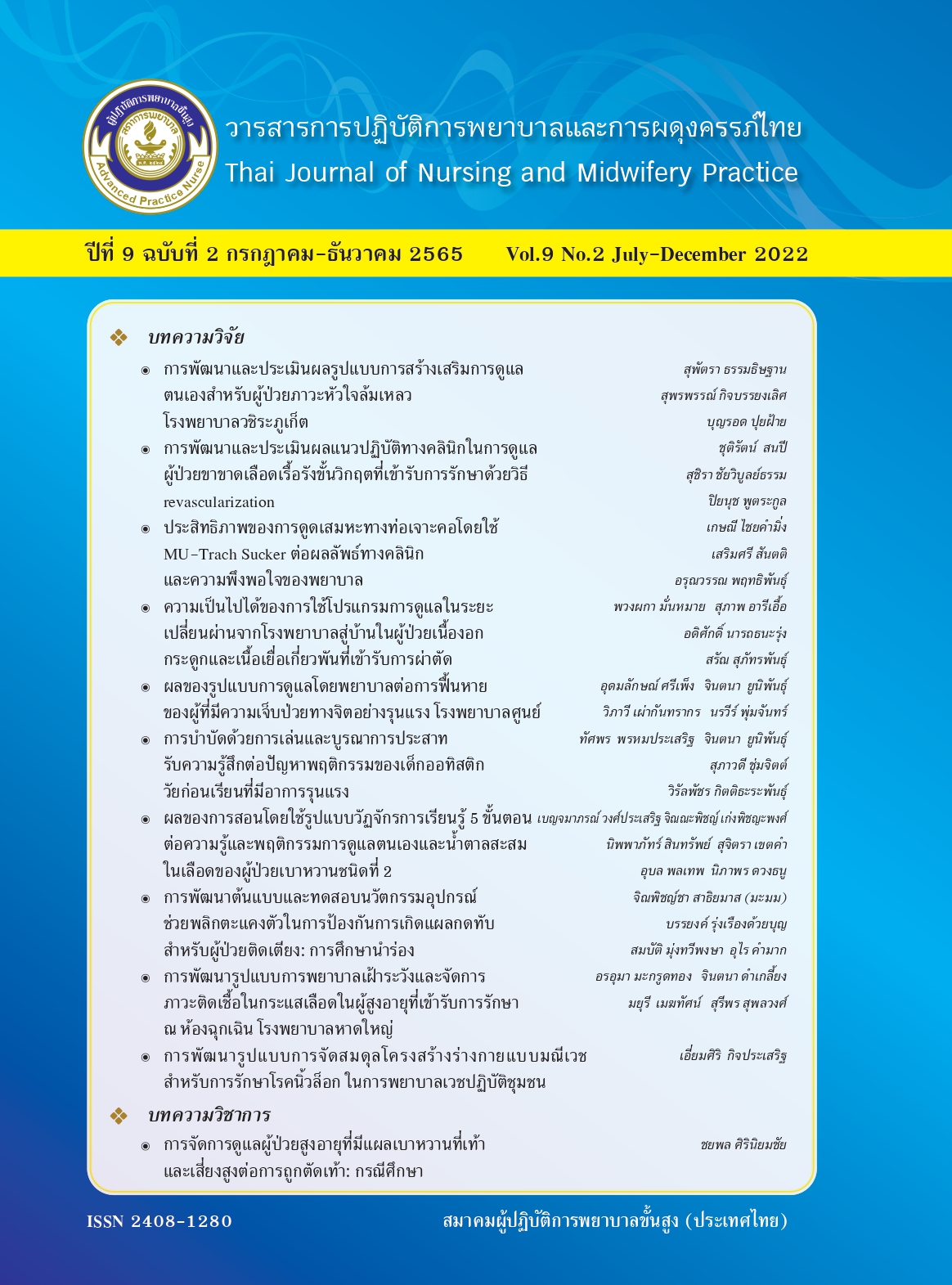Development and Evaluation of Clinical Practice Guideline for Patients with Critical Limb Ischemia Undergoing Revascularization
Main Article Content
Abstract
This research study is the develop and evaluate of the implement clinical practice guideline (CPG) for patients with critical limb ischemia (CLI) undergoing revascularization in a university hospital. The sample consisted of 18 surgical residents, 9 outpatient surgery nurses, 30 intensive care unit nurses, 42 general ward nurses, and 12 CLI patients who undergone revascularization. Data were collected with research instruments, personal data questionnaire, personnel adherence to CPG record form, personnel satisfaction questionnaire, patient opinions questionnaire after implementing CPG, and clinical outcomes record form. Data were analyzed using descriptive statistics. The results of the study showed that personnel cooperated to almost activities following the CPG implementation. They reported a high level of satisfaction with the CPG implementation. Patients had no clinical complications, the length of stays in endovascular patients was minimum 4 days, maximum 43 days and those after bypass surgery was 29 days. The patients reported their opinion that they received the best care in regard to: receiving good service from specialized medical professionals (91.7%), explaining problems and illness and applying advice to action (83.3%), and receiving prompt treatment (83.3%), gaining easy and convenient access to services from nurses (91.7%), helping immediately, listening to health problems and following up continuously (83.3%). Implementation of this clinical practice guidelines in the departments can improve patient clinical outcomes.
Downloads
Article Details

This work is licensed under a Creative Commons Attribution-NonCommercial-NoDerivatives 4.0 International License.
References
Norgren L, Hiatt WR, Dormandy JA, Nehler MR, HarrisKA,FowkesFG,etal.Inter-societyconsensus for the management of peripheral arterial disease (TASC II).JVascSurg. 2007 Jan;45 SupplS:S5-67.
TeraaM, ConteMS,MollFL, VerhaarMC. Critical limb ischemia: current trends and future directions. J Am Heart Assoc. 2016 Feb 23;5(2):e002938.
Conte MS, Bradbury AW, KolhP, White JV, Dick F,Fitridge R,etal.Global vascular guidelines on the management of chronic limb threatening ischemia.J VascSurg. 2019 Jun;69(6S):3S-125S.e40.
Farber A, Eberhardt RT. The current stateofcritical limb ischemia: A systematic review. JAMA Surg.2016 Nov 1;151(11):1070-77.
Jung HJ, LeeSS, Kim HY,Park BS, Kim DI, Nam KJ,etal. Association between carotidartery stenosis and peripheralarterydisease: Evaluation by screening carotid ultrasonography (cross-sectional study). Medicine(Baltimore). 2019 Feb;98(6):e14163.
Uengtrakul S, Namvongprom A, Pakdevong N. Effects of the coronary artery bypass graft nursing care protocolonlength of stay,and patient satisfaction. Thai Journal of Cardio-Thoracic Nursing. 2012;23(2):31-42.(In Thai).
Ruangwiset R, Wanitkun N, Danidusadeekul S, WongkongkamK, ChinsakchaiK. Predictive factors in peripheral arterial occlusive disease patients’ recuperation after endovascular surgery.ThaiJournal of Nursing Council. 2017;32(2):79-94.(InThai).
Maleux G, Koolen M, HeyeS. Complications after endovascular aneurysm repair. In Prayooltem R, Moundeage M, Vongwitsanupong N, Eds. Outcomes of implementing nursing care management plan for patients undergoing vascular surgery: A case study at Songklanagarind hospital. Princess of Naradhiwas university Journal. 2018;10(3):81-93.(In Thai).
Iida O, Takahara M, Soga Y, Azuma N, Nanto S, Uematsu M. Prognostic impact of revascularization inpoor riskpatientswithcritical limbischemia: The PRIORITY Registry (poor-risk patients with and without revascularization therapy for critical limb ischemia). JACC Cardiovasc Interv. 2017 Jun12;10(11):1147-57.
Prayooltem R,Vongwisanupong N, Songwathana P. Improvement of discharge planning and continuing careforvascularsurgerypatients:Acasestudy. Thai Journal of Nursing Council. 2019;34(2):5-17.(In Thai).
Sopittapan B, Kanogsunthornrat N, Siripitayakunkit A. Knowledge and self-care practice in patients with
peripheralarterialocclusivedisease. Thai Journal of Cardio-ThoracicNursing. 2018;29(2):43-54.(InThai).
Hussain MA, Al-Omran M, Mamdani M, Eisenberg N, Premji A, Saldanha L, etal. Efficacyofaguideline recommended risk reduction program to improve cardiovascular and limb outcomes in patients with peripheral arterial disease.JAMA Surg.2016;151(8):742–50.
Saelim R, Vongwisanupong N, Triprakong S. Effectiveness of adischarge planning programme on self-care knowledge and behaviour of peripheral arterial occlusion patients at Songkhla Nakharin hospital. Thai Journal of Nursing Council. 2014;29(2):101-13.(In Thai).
Wanthanatas R. Factors affecting professional nurses’performance based on the nursing process at Nakhonpathom hospital, Nakhonpathom province. Nursing Journal of the Ministry of Public Health. 2016;26(2):103–15. (In Thai).
Siripukdeekan C, Boonrubpayap B. Nursing career ladder development. Journal of The Royal Thai Army Nurses. 2014;15(3):75-80.
Fereydooni A, Gorecka J, Dardik A. Using the epidemiology of critical limb ischemia to estimate the number of patients amenable to endovascular therapy. Vasc Med. 2020 Feb;25(1):78-87.
Levin SR, Arinze N, Siracuse JJ. Lower extremity critical limbischemia: A review of clinical features and management. Trends Cardiovasc Med. 2020 Apr;30(3):125-130.
Martini R. Trends of the treatment of critical limb ischemiaduringthelast twodecades.ClinHemorheol Microcirc. 2018;69(4):447-56.
Uccioli L,MeloniM, Izzo V, Giurato L,MerollaS, GandiniR.Critical limb ischemia:current challenges and future prospects.Vasc Health Risk Manag. 2018 Apr 26;14:63-74.
Bisgaard J, Torp-Pedersen C, Rasmussen BS, Houlind KC, Riddersholm SJ. Editor’s choice - regional versus general anaesthesia in peripheral vascular surgery: a propensity score matched nationwide cohort study of 17 359 procedures in Denmark. Eur J Vasc Endovasc Surg. 2021 Mar;61(3):430-38.
Roberts DJ, Dreksler H, NagpalSK, Li A,Parsons LJ, Brandys T, et al. Outcomes after receipt of neuraxial or regional anesthesia instead of general anesthesia for lower limbrevascularization surgery: protocol for a system aticre view and meta-analysis. JMIR ResProtoc. 2021 Nov 26;10(11):e32170.
JanczakD, MalinowskiM, BakowskiW, Krakowska K, MarschollekK, MarschollekP, etal. Comparison of the incidence of complications and secondary surgical interventions necessary in patients with chronic lower limb ischemia treated by both open andendovascularsurgeries. Ann Thorac Cardiovasc Surg. 2017 Jun 20;23(3):135-40.
AitkenSJ, Choy OS,MonaroS. A qualitativestudy exploring patient concerns and values in chronic limb-threatening ischemia. J Surg Res. 2019 Nov;243:289-300.


